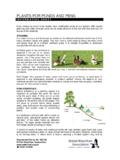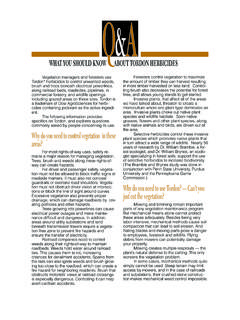Transcription of POLLINATOR S Great Lakes Region - The Xerces Society
1 Butterfly milkweed, purple giant hyssop, and purple prairie cloverThe Great Lakes Region includes an incredibly diverse range of plant communities from wild blueberry barrens and northern boreal forest in Ontario and northern Minnesota, to tallgrass prairie in Wisconsin and Ohio, and mixed broadleaf forests in Ohio, Michigan, Pennsylvania, and New York. Corresponding to this striking diversity of plant communities is an equally remarkable range of pollinators including the endangered Karner blue butterfly (Lycaeides melissa samuelis), more than 20 species of bumble bees (Bombus spp.) including the federally endangered rusty-patched bumble bee (B.)
2 Affinis) and the northernmost population of migrating monarch butterflies (Danaus plexippus). As a group, these and other pollinators maintain healthy, productive plant communities, provide food that sustains wildlife, and play an essential role in crop production. Providing wildflower-rich habitat is the most significant action you can take to support pollinators. Adult bees, butterflies, and other pollinators require nectar as their primary food source. Female bees also collect pollen as food for their offspring. Native plants, which are adapted to local soils and climates, are usually the best sources of nectar and pollen for native pollinators.
3 Incorporating native wildflowers, shrubs, and trees into any landscape promotes local biological diversity and provides shelter and food for a diversity of wildlife. Additional advantages of native plants are that they often require less water than non-natives, do not require fertilizers, and are less likely to become guide features regional native plants that are highly attractive to pollinators and are well-suited for small-scale plantings in gardens, on business and school campuses, in urban greenspaces, and in farm field borders. In addition to supporting native bees and honey bees, many of these plants attract nectar-seeking butterflies, moths, and hummingbirds, and some are host plants for butterfly and moth caterpillars.
4 With few exceptions, these species occur broadly across the Region and can be purchased as seed or transplants. Please consult regional Floras, the Biota of North America s North American Plant Atlas ( ), or the USDA s PLANTS database ( ) for details on species s distributions in your PLANTSOur Bring Back the Pollinators campaign is based on four principles:1. Grow a variety of POLLINATOR -friendly flowers;2. Protect and provide bee nest sites and caterpillar host plants;3. Avoid using pesticides, especially insecticides; and4. Spread the word!You can participate by taking the POLLINATOR Protection Pledge and registering your habitat on our nationwide map Lakes Region1314151617181920212223241234567891 01112 Bloom PeriodCommon NameScientific NameLife Cycle*Flower ColorMax.
5 Height Water NeedsNotesThis list of POLLINATOR plants for the Great Lakes Region was produced by the Xerces Society . For more information about POLLINATOR conservation, please visit (Feet)L: low; M: medium; H: high*Life Cycle abbreviations: A: annual; P: perennial; B: biennial. Max. Height is an average, individual plants may vary. Early1 Lanceleaf coreopsisCoreopsis lanceolataPyellow2 LThis early bloomer can hold its own among grasses and taller species; bees and syrphid flies are common visitors2 Smooth penstemonPenstemon digitalisPwhite2 MSemi-evergreen; prolific nectar producer; visited by a huge diversity of butterflies, moths, and bees, including honey bees3 Wild lupineLupinus perennisPblue2 LLarval host plant for the endangered Karner blue butterfly (Lycaeides melissa samuelis; shown), and various other blue butterfliesMid4 Butterfly milkweedAsclepias tuberosaPorange3 LMilkweeds (Asclepias spp.)
6 Are host plants for the monarch butterfly (Danaus plexippus), and nectar sources for many bees5 Dotted mintMonarda punctataA, B, Ppurple3 MTolerates dry, sandy soils; blooms prolifically; highly attractive to beneficial wasps and bees, including honey bees6 Great blue lobeliaLobelia siphiliticaPblue3 HGreat blue lobelia is an exceptional bumble bee plant, and is excellent for rain gardens7 Purple coneflowerEchinacea purpureaPpurple4 MVisitors include bees in the genera Bombus, Melissodes, and Svastra, and the leafcutter bee (Megachile pugnata)8 Purple prairie cloverDalea purpureaPpurple2 LHoney bees and bumble bees are voracious visitors, as well as several specialist polyester bees (Colletes spp.)
7 9 Virginia mountain mintPycnanthemum virginianumPwhite3 MThis and related species have fragrant foliage, and are visited by blue and copper butterflies, honey bees, and more10 Wild bergamotMonarda fistulosa Ppurple4 MHawk moths, hummingbirds, and long-tongued bumble bees (such as Bombus pensylvanicus) are common visitorsMid Late11 Cup plantSilphium perfoliatumPyellow8 MAttracts many bees and butterflies; thick hollow stems make excellent nests for leafcutter bees and small carpenter bees (Ceratina spp.)12 Prairie blazing starLiatris pycnostachyaPpurple5 MBlazingstars (Liatris spp.) support a broad community of butterflies including monarchs, swallowtails, skippers, and sulfurs13 Purple giant hyssopAgastache scrophulariifoliaPpurple6 MThis and other wild hyssops (Agastache spp.)
8 Provide long-lasting, nectar-rich flowers and mint-like foliage14 Rattlesnake masterEryngium yuccifoliumPwhite5 MAttracts incredible insect diversity and is the host plant for the rattlesnake master borer moth (Papaipema eryngii)15 Joe Pye weedEutrochium fistulosumPpink7 HPrimarily known as a butterfly plant, Joe Pye weed also attracts bees; tolerant of partial shade and wet soils16 WingstemVerbesina alternifoliaPyellow6HA major honey producer; Great as a shade-tolerant rain garden or wetland edge plant; may be hard to find in nurseriesLate17 Bottle gentianGentiana andrewsiiPblue2 MIts flower petals never open; almost exclusively pollinated by bumble bees, which pry the petals apart to climb inside18 Calico asterSymphyotrichum lateriflorumPwhite3 MIts shallow nectaries attract more insect diversity than some related species; is also tolerant of partial shade19 Field thistleCirsium discolorB, Ppurple6 MNot to be confused with non-native thistles; a now uncommon but important plant for butterflies and bumble bees20 New England asterSymphyotrichum novae-angliaePpurple6 MOne of the latest fall-blooming plants; frequented by honey bees and pre-hibernation bumble bee queens21 Showy goldenrodSolidago speciosaPyellow5 MGoldenrods (Solidago spp.)
9 Are frequented by beneficial solitary wasps, pollen-eating soldier beetles, honey bees, and much moreShrubs and TreesEarly Mid22 Cockspur hawthornCrataegus crus-galliPwhite35 LTough native tree that attracts bumble bees, honey bees, species of mining bees (Andrena spp.), as well as songbirdsMid23 LeadplantAmorpha canescensPpurple3 LLeadplant is generally tolerant of disturbed soils; readily visited by leafcutter bees, honey bees, and other beneficial insects24 New Jersey tea Ceanothus americanusPwhite4 MPollinator magnet that attracts species of flies, wasps, bees, and butterflies; slow growing and prone to deer browsingAcknowledgmentsPlanting for Success Sun ExposureMost POLLINATOR -friendly plants prefer sites that receive full sun throughout most of the day and are mostly open, with few large trees.
10 A southern exposure can provide the warmest habitat, but is not required. Plant DiversityChoosing a variety of plants with overlapping and sequential bloom periods will provide food for pollinators throughout the Size and ShapeHabitat patches that are bigger and closer to other patches are generally better than those that are smaller and more isolated from one another. However, even a small container garden can attract and support pollinators! Planting LayoutFlowers clustered into clumps of one species will attract more pollinators than individual plants scattered through a habitat patch. Where space allows, plant clumps of the same species within a few feet of one or TransplantsIt is usually cheaper to establish large habitat areas from seed; however, seeding native wildflowers on a large-scale is an art unto itself.









